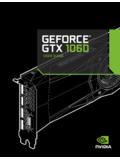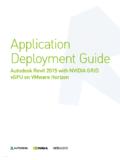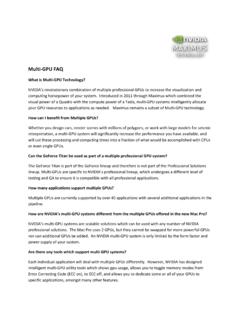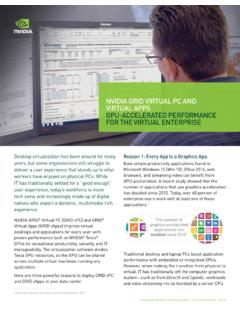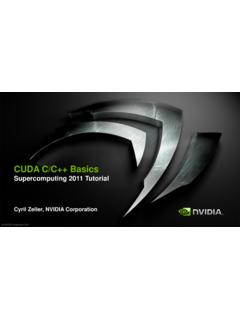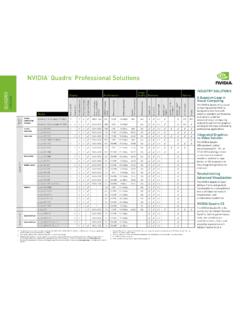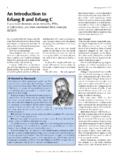Transcription of Introduction to CUDA C - Nvidia
1 San Jose Convention Center | September 20, 2010 Introduction to cuda CWho Am I? Jason Sanders Senior Software Engineer, Nvidia Co-author of cuda by ExampleWhat is cuda ? cuda Architecture Expose general-purpose GPU computing as first-class capability Retain traditional DirectX/OpenGL graphics performance cuda C Based on industry-standard C A handful of language extensions to allow heterogeneous programs Straightforward APIs to manage devices, memory, etc. This talk will introduce you to cuda CIntroduction to cuda C What will you learn today? Start from Hello, World! Write and launch cuda C kernels Manage GPU memory Run parallel kernels in cuda C Parallel communication and synchronization Race conditions and atomic operationsCUDA C Prerequisites You (probably) need experience with C or C++ You do not need any GPU experience You do not need any graphics experience You do not need any parallel programming experienceCUDA C: The BasicsHostNote: Figure Not to Scale Terminology Host The CPU and its memory (host memory) Device The GPU and its memory (device memory)DeviceHello, World!
2 Intmain( void) {printf( "Hello, World!\n" );return 0;} This basic program is just standard C that runs on the host Nvidia s compiler (nvcc) will not complain about cuda programs with no device code At its simplest, cuda C is just C!Hello, World! with Device Code__global__ voidkernel( void) {} int main( void) {kernel<<<1,1>>>();printf( "Hello, World!\n" );return0;} Two notable additions to the original Hello, World! Hello, World! with Device Code__global__ voidkernel( void) {} cuda C keyword __global__ indicates that a function Runs on the device Called from host code nvccsplits source file into host and device components Nvidia s compiler handles device functions like kernel() Standard host compiler handles host functions like main() gcc Microsoft Visual CHello, World!
3 With Device Codeintmain( void) {kernel<<< 1, 1 >>>();printf( "Hello, World!\n" );return 0;} Triple angle brackets mark a call from hostcode to devicecode Sometimes called a kernel launch We ll discuss the parameters inside the angle brackets later This is all that s required to execute a function on the GPU! The function kernel()does nothing, so this is fairly More Complex Example A simple kernel to add two integers:__global__ voidadd( int *a, int *b, int *c ) {*c = *a + *b;} As before, __global__ is a cuda C keyword meaning add()will execute on the device add()willbe called from the hostA More Complex Example Notice that we use pointers for our variables:__global__ voidadd( int *a, int *b, int *c ) {*c = *a + *b;} add()runs on the a, b, and cmust point to device memory How do we allocate memory on the GPU?
4 Memory Management Host and device memory are distinct entities Device pointers point to GPU memory May be passed to and from host code May not be dereferencedfrom host code Host pointers point to CPU memory May be passed to and from device code May not be dereferencedfrom device code Basic cuda API for dealing with device memory cudaMalloc(), cudaFree(), cudaMemcpy() Similar to their C equivalents, malloc(), free(), memcpy()A More Complex Example: add() Using our add()kernel:__global__ voidadd( int*a, int*b, int*c ) {*c = *a + *b;} Let s take a look at main()..A More Complex Example: main()intmain( void ) {inta, b, c; // host copies of a, b, cint*dev_a, *dev_b, *dev_c; // device copies of a, b, cintsize = sizeof( int); // we need space for an integer// allocate device copies of a, b, ccudaMalloc( (void**)&dev_a, size );cudaMalloc( (void**)&dev_b, size );cudaMalloc( (void**)&dev_c, size );a = 2;b = 7;A More Complex Example: main()(cont)// copy inputs to devicecudaMemcpy( dev_a, &a, size, cudaMemcpyHostToDevice);cudaMemcpy( dev_b, &b, size, cudaMemcpyHostToDevice);// launch add() kernel on GPU, passing parametersadd<<< 1, 1 >>>( dev_a, dev_b, dev_c).}
5 // copy device result back to host copy of ccudaMemcpy( &c, dev_c, size, cudaMemcpyDeviceToHost);cudaFree( dev_a);cudaFree( dev_b);cudaFree( dev_c);return0;}Parallel Programming in cuda C But computing is about massive parallelism So how do we run code in parallel on the device? Solution lies in the parameters between the triple angle brackets:add<<< 1, 1 >>>( dev_a, dev_b, dev_c);add<<< N, 1 >>>( dev_a, dev_b, dev_c); Instead of executing add()once, add()executed Ntimes in parallelParallel Programming in cuda C With add()running in s do vector addition Terminology: Each parallel invocation of add()referred to as a block Kernel can refer to its block s index with the variable Each block adds a value from a[]and b[], storing the result in c[]:__global__ voidadd( int*a, int*b, int*c ) {c[ ] = a[ ] + b[ ].
6 } By using index arrays, each block handles different indicesParallel Programming in cuda CBlock 1c[1] = a[1] + b[1]; We write this code:__global__ voidadd( int*a, int *b, int *c ) {c[ ] = a[ ] + b[ ];} Thisis what runs in parallel on the device:Block 0c[0] = a[0] + b[0];Block 2c[2] = a[2] + b[2];Block 3c[3] = a[3] + b[3];Parallel Addition: add() Using our newly parallelized add()kernel:__global__ voidadd( int*a, int*b, int*c ) {c[ ] = a[ ] + b[ ];} Let s take a look at main()..Parallel Addition: main()#define N 512intmain( void ) {int*a, *b, *c; // host copies of a, b, cint*dev_a, *dev_b, *dev_c; // device copies of a, b, cintsize = N *sizeof( int); // we need space for 512 integers// allocate device copies of a, b, ccudaMalloc( (void**)&dev_a, size );cudaMalloc( (void**)&dev_b, size );cudaMalloc( (void**)&dev_c, size );a = (int*)malloc( size ); b = (int*)malloc( size );c = (int*)malloc( size );random_ints( a, N ); random_ints( b, N );Parallel Addition: main()(cont)// copy inputs to devicecudaMemcpy( dev_a, a, size, cudaMemcpyHostToDevice).
7 CudaMemcpy( dev_b, b, size, cudaMemcpyHostToDevice);// launch add() kernel with N parallel blocksadd<<< N, 1 >>>( dev_a, dev_b, dev_c);// copy device result back to host copy of ccudaMemcpy( c, dev_c, size, cudaMemcpyDeviceToHost);free( a ); free( b ); free( c );cudaFree( dev_a);cudaFree( dev_b);cudaFree( dev_c);return0;}Review Difference between host and device Host = CPU Device = GPU Using __global__ to declare a function as device code Runs on device Called from host Passing parameters from host code to a device functionReview (cont) Basic device memory management cudaMalloc() cudaMemcpy() cudaFree() Launching parallel kernels Launch Ncopies of add()with: add<<< N, 1 >>>().
8 Used access block s indexThreads Terminology: A block can be split into parallel threads Let s change vector addition to use parallel threads instead of parallel blocks:__global__ voidadd( int*a, int*b, int*c ) {c[ ] = a[ ] + b[ ];} We use of add() main()will require one change as Addition (Threads): main()#define N 512int main( void ) {int *a, *b, *c; //host copies of a, b, cint *dev_a, *dev_b, *dev_c; //device copies of a, b, cint size = N * sizeof( int); //we need space for 512 integers// allocate device copies of a, b, ccudaMalloc( (void**)&dev_a, size );cudaMalloc( (void**)&dev_b, size );cudaMalloc( (void**)&dev_c, size );a = (int*)malloc( size ); b = (int*)malloc( size );c = (int*)malloc( size );random_ints( a, N ); random_ints( b, N );Parallel Addition (Threads): main()(cont)// copy inputs to devicecudaMemcpy( dev_a, a, size, cudaMemcpyHostToDevice);cudaMemcpy( dev_b, b, size, cudaMemcpyHostToDevice);// launch add() kernel with Nadd<<< >>>( dev_a, dev_b, dev_c);// copy device result back to host copy of ccudaMemcpy( c, dev_c, size, cudaMemcpyDeviceToHost).}
9 Free( a ); free( b ); free( c );cudaFree( dev_a);cudaFree( dev_b);cudaFree( dev_c);return0;}threads1, N blocksN, 1 Using Threads AndBlocks We ve seen parallel vector addition using Many blocks with 1 thread apiece 1 block with many threads Let s adapt vector addition to use lots of bothblocks and threads After using threads and blocks together, we ll talk about whythreads First let s discuss data Arrays With Threads And Blocks No longer as simple as just using indices To index array with 1 thread per entry (using 8 threads/block) If we have Mthreads/block, a unique array index for each entry given byintindex = + * M;intindex = x + y * width.
10 = = = = Arrays: Example In this example, the red entry would have an index of 21:intindex = + * M;= 5 + 2 * 8;= 21; = 2M = 8 threads/block017816181920212134567109111 2131415 Addition with Threads and Blocks The a built-in variable for threads per block:int index= + * ; A combined version of our vector addition kernel to use blocks andthreads:__global__ voidadd( int *a, int *b, int *c ) {int index = + * ;c[index] = a[index] + b[index];} So what changes in main()when we use both blocks and threads?Parallel Addition (Blocks/Threads): main()#define N (2048*2048)#define THREADS_PER_BLOCK 512int main( void ) {int *a, *b, *c; // host copies of a, b, cint *dev_a, *dev_b, *dev_c; // device copies of a, b, cint size = N * sizeof( int ); // we need space for N integers// allocate device copies of a, b, ccudaMalloc( (void**)&dev_a, size );cudaMalloc( (void**)&dev_b, size );cudaMalloc( (void**)&dev_c, size );a = (int *)malloc()}

